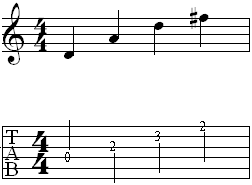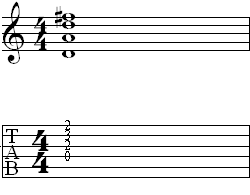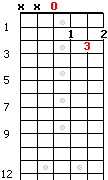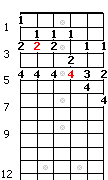TAB or tablature is a way for guitarists to "read" music without having to learn standard
notation. It is easy to learn and is the most popular form of notation for guitar. It uses
ordinary characters and numbers so it is easily written out. TAB will tell you all the
necessary things you need to know about the piece you are wanting to play such as tuning, tempo,
hammer-ons, etc. TAB is simple to learn and there are literally thousands of songs on the internet
you can learn to play using tablature.
Before we begin, lay your guitar down in your lap (with the strings facing the ceiling). This is
so you will not get disoriented while we identify the strings on the guitar and associate it with
tablature.
On the guitar, there are 6-strings. They are numbered from 1 to 6 - the first being the thinnest and
the 6th being the thickest.

Tablature is a six-line staff that represents the guitar fingerboard. The top line indicates the
highest sounding string (high e).

Numbers on the string lines represent which fret is to be played. By placing a number on the appropriate
line, the string and fret of any note can be indicated. The number 0 represents an open string.
If the numbers are written out like this, they are to be played one at a time.
(Let each note ring out while you hit the next.)

Numbers written on top of each other are to be played all at once (called a "strum").

Extra Characters
Extra characters are used to tell "how" to play something.
h - hammer on
p - pull off
b - bend string
r - release bend
/ - slide up
\ - slide down
v - vibrato (sometimes written as ~)
t - right hand tap
x - play 'note' with heavy damping
We'll cover these as we come across them. There is really no sense in just memorizing them. They
will "stick" better if you actually put them to use while you are learning.
Grids
Reading grids is about the same. The 6 lines represent the strings of the guitar. The dark line
at the top is the nut. The numbers on the lines are finger numbers and the horizontal lines represent
frets - the vertical lines represent the strings (from left to right - 6 - thickest, 5, 4, 3, 2, 1 - thinnest).
(The O on the D chord grid means let that string ring out with the chord.)
Below is a grid representation of an open D chord and a C Major scale. The red finger numbers are the root notes.


|
|







